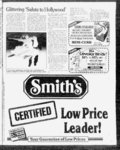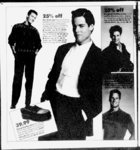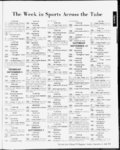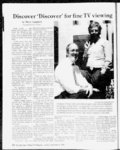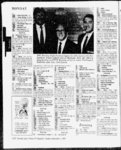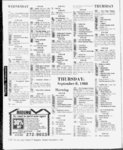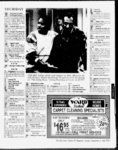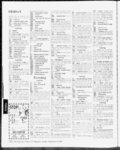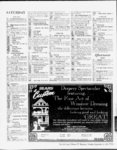| Show 2T The Salt Lake Ti ibune Sunday September 4 1988 All decked out: A guide to cruise ships’ great outdoors Continued from T-- l and then finally ignore? This is a rare vexing question of deck etiquette for walkers My recommendation: Once is enough Joggers say that tight squeezes raise another question of deck etiquette When decks narrow pass like ships port to port where single file is required forward walkers have priority Walking is not the only form of exercise available on deck While the most popular game — shuffleboard — is haidly strenuous every ship also offers deck tennis volleyball basketball deck quoits and nowa days a computerized driving range for golf addicts lie de France passengers used to play miniature golf those on Royal Viking Sun now can try croquet On every ship aerobics classes are held each morning at sea After a hearty constitutional or an a exacting game of shuffleboard cool dip might seem in order Let's go up to the Pool also called Sun Deck Sports Deck or Top Deck for a swim or more sitting — this time in the sun What a complex business it is! I once watched a couple arrive for their day on deck rested and ready for a relaxing session in the sun They carried towels beach bags books puzzles tape recorders and suntan lotion and wore new sandals All cruise passengers have new shoes They — like me — did their rail bit first then surveyed the rows of chairs No longer deck chairs they are pool chairs now plastic and aluminum instead of mahogany similarly sunbaked decks covered with Astroturf are easier on bare feet They selected two chairs placed neatly in line and after consulting the angle of sun pulled them out of line Then they spread towels over chairs shucked sandals doffed sun coverups spread selves on towels oiled abdomens slathered each other’s backs adjusted hats hung sunglasses on noses removed them at once to wipe lotion smears from the lenses and finally shrugged into prime sunning mode Peace? Not yet Moments later up from the chair removed hat and glases put on sandals pocketed sunglasses showered and splashed into pool Then out for another shower resumed hat glasses and more unguents lay down Got up to shift chair — sun or ship had moved slightly Resumed prone mode Read for two minutes Time for a drink Deck steward summoned order given money produced Hat off sunglasses — what a job! Whenever you admire a cruise passenger’s tan don’t equate it with idleness: It involves excruciating labor One of the deck s unending delights is the convenient and tempting proximity of pool and food An buffet is a hallmark of the passenger vessel and started in 1838 on the Great Western Hark to the diary of Mr Foster who described himself as "a highly talented Gentleman of Philadelphia ” He recalled 'The skylights to our cabin abaft are made to form two tables on deck mahogany topped with a most witching look of invitation to a repast upon them whenever a smooth sea and sunny day make it pleasant to dine or lunch beneath the awning Wine and fruit had been set out upon them for this purpose” There it was a North Atlantic first” 130 years ago modest forerunner of thousands of ambitous spreads to follow Today's cruising passengers clad in bathing suits invariably take breakfast lunch and tea on deck near their pools The sun sets and the pool is stilled A final gathering of throng the rails waiting for that orange muted disc to sink out of sight Soon the deck is abandoned except for the stewards stacking chairs gathering up plastic drinking glasses maraschino cherries soggy towels and always a dozen items for lost and found Deck lights come on and ’ deck-watcher- s the action moves indoors Nighttime passenger activities are confined to the public rooms White shaiks the name given to junior officers resplendent in tropical whites prowl the discotheques in search of susceptible lady passengers traveling alone With a willing conquest in tow the white shark mov es to the protective coloration of his cabin Those in quest of romance under the stars will find the deck almost deserted But complete privacy was easier in the old days when lifeboats rested on deckboard cradles creat- ing convenient hidden recesses here couples could remain in touch with each other and the sea but no one else Nowadays lifeboats are high above rails straight and fluorescent deck lights omnipresent Cruel disappointment is in store for couples who hope to stand by the rail at night in that traditional pose so beloved of cruise ship publicity departments ”He” is alw ays in black tie “she” in frothy chiffon they gaze alternately into each other’s eyes or out to sea They sip champagne One holds a cigarette in an ivory holder Alas an unlikely scenario Decks after dark at sea tend to be windy and cold even in the tropics It is likely he will have to surrender his w jacket to her Her hair and dress will be threatened if not destroyed by wind champagne tries to leave the glass But persevere regardless If you’re lucky enough to have a full moon there is nothing prettier in the world than its dappled river of light — origin of the song "Moon River” — linking ship's rail to horizon while the restless night sea foams past For those intent on a celestial view the same deck lights that create difficulties for courting couples make things difficult for genuine stargazers The solution? Hasten forward to the crescent of deck beneath the bridge There lights have been ruthlessly extinguished to aid the night vision of the charged with navigating the vessel Watching is not confined to stargazers or navigation officers Watchers are a potent deck force watching over the rails watching the captain dock the vessel watching crewmen paint the davits watching longshoremen load cargo In they watch — what? I am a watcher myself and inevitably as I come on deck for the first time each day carrying my book or letters I cannot resist a ritual visit to the rail I lean for a moment on its comfortable mahog officer-of-the-watc- h mid-ocea- n any top and gaze over the water What am I looking for? I am never sure What is there to see? Usually nothing Sometimes a bird occasionally a piece of flotsam or seaweed another ship perhaps God willing or even a whale If I miss any of the above a neighboring watcher will be sure to point it out At cruise's end all we’re all watchers There’s no more walking jogging swimming eating or even romance Our last morning the decks encompass a lingering throng of fellow passengers now bonded by cruising some still wearing paper leis from last night’s gala or unpackable straw hats (The Caribbean weaver who perfects the packable straw hat will make his or her fortune) Others pose newfound week-olfriends against the rail for one final picture Most passengers crowding the decks before disembarking will be back They will again pack new shoes and bathing suits reboard another ship and once again spend most of their cruise where cruise passengers belong out on deck is a noted (John Maxtone-Grahamaritime historian and the author of “The Only Way to Cross ” and its sequel “Liners to the Sun ” He often sails on cruises as a lecturer) d Outside of Rome Hadrian’s Villa gives you a view of the Roman Empire Story and photo by Nino Lo Bello ROME — Now for the big one — a travel subject that hasn’t been covto zzzzzzz It’s Haered from drian’s Villa just 18 miles outside of the Eternal City and it’s guaranteed to give the most-savvtraveler Brownie Points for Providing one and all with the aura of being on a film set that evokes the grandeur of the Empire the Villa Adriana (its name in Italian) is a stunning complex of plundered palaces theaters baths gymnasiums and mosaic works pillaged over the centuries When in Rome do what all good tourists do — go! Open from 9 a m to sunset every day of the year Hadrian’s Villa is easy to do because Rome’s travel agencies make daily tours to the immense acreage of ruins where you may wander freely Comprising an estate of hundreds of structures thousands of rooms a dozen pools — all put together by slaves — Hadrian's Villa was really a villa-citand the queen of imperial residences of the ancient world The original covered about 750 acres (seemingly bigger than Rhode Island) but today only 150 acres have been excavated and are open to the public — enough to keep any visitor busy for at least half a day The splendid ruins enable you to reconstruct in your mind’s eye what this leftover from the Empire looked like to weekend guests in 135 A D when the last colored mosaic stone was stuck into its calculated position Emperor of Rome from A D Hadrian preferred to rule his ho-hu- y y 117-13- 8 sprawling Empire by traveling often on foot through each of his provinces for 12 of the 20 years of his reign in order to understand firsthand the different cultures and their problems Gifted with a prodigious memory Hadrian was an architect painter sculptor poet musician philosopher and a medical doctor Necessarily he would have to be considered the greatest of Rome’s emperors The artistic tastes of this superior ruler show up like bright lights in his villa Fun to him was to recreate and preserve here the places and works of art that caught his fancy while living in Rome’s conquered lands He was thus forever expanding his villa — which today stands as his gift to posterity and a memorial to his name As you enter the grounds of Hadrian's pet project along a road lined with centuries-ol- d cypress tress the little Greek theater attracts you first because its form is still nicely preserved But its name belies the fact that it is actually a semicircular typical Roman theater From there you find signs clearly marked with maps and descriptions (in several languages English included l that lead you past the Temple of Venus to the Valley of Tempe (the original is in north Greece) and the Zone of Poos Acting as a kind of link between two zones the Island Nympheum is the most original and beautiful of the villa’s structures Originally people crossed from a vestibule and a round portico over a circular canal on two swing bridges to reach the island — on which were an atrium library thermal baths and a dining room All these rooms opened onto a central courtyard with a swimming pool in the middle obviously Hadrian’s choice spot to get away from it all Because 16th Century scholars knew that Hadrian loved Athens above all other cities they named the various buildings as though Hadrian had them from original Greek structures which he didn’t — he was his own architect A point in fact is the Poecile (or Stoa Poikile) With a totally different form and seven times the size of the famous Greek Poikile Hadrian's Poecile is one of the five zones in the Villa that alone encloses an area of 232 by 97 meters with buildings gardens horse racing tracks a huge fish pond and a pool bigger than a football field (106 by 26 meters) which is now the luxurious home of a brigade of ducks Laid out so that the whole complex conformed to the natural terrain the villa makes a strong break with the whole of Hellenistic and Roman architecture with Hadrian emerging today as the genius some 18 centuries ahead of his time in town planning principles incorporated by Hadrian have been recognized by such greats as Frank Lloyd Wright and Louis Kahn making the emperor appeal today as the most important architect of the ancient world Three elements unite all the sections of the villa: the interspersing of gardens between constructions a large number of porticos and peristyles providing covered paswith various sages and link-up- s buildings and a great abundance of fountains pools and canals making water actually a component of the Town-plannin- city-size- g architecture Indeed water actually dominates the most spectacular zone of the villa the Zone of the with a grandiose pool (119 by 18 meters) hollowed out at the foot of a natural valley and pointing towards a large building and alcove Reflected in the long pool are six statues which once supported a trellis which had collapsed onto the pool and remained buried till excavations began At one end is the typical form of Baths-Canopu- In city-sizHadrian 's Villa you get feeling of being on film set that evokes grandeur that was once the Roman Empire e s a dining couch where the emperor and his guests stretched out to eat sumptuous meals freshened by a kind of Rube Goldberg air conditionair of ing system — the water-coolethe smaller pools and water which sprayed around the niches and back into the large pool Along the right side of this pool is a series of buildings one of which is today a special museum that holds some fine examples of Greek and Roman art Perhaps the two most valuable statues here are the pair of wounded Amazons who are strug- gling to stay on their feet and continue battle What is missing from the great ex- panse of Hadrian's Villa is the exter- nal covering in its original state — columns capitals friezes and col- ored marbles — which were stolen and now decorate noble houses and museums in Rome and in other European cities Although Hadrian realized his architectural dream of the future no dream could have told him that his villa would be enjoyed by sightseers from the 20th Century as one of the wonders of ancient Italy Dumfounding everybody who pays a call Hadrian's Villa comes in easily with a rating of five stars — and if there were such a thing as an Academy Award for “The Best Tourist Attraction of The Past in The Present” the place would simply run away with the Oscar Nino Lo Bello lives in Vienna d ' ' ' Austria principality Fairy-tal- e Liechtenstein’s landscape literally bursts with color By Michael Limon Dallas Morning News Liechtenstein — It's cliche but the rain clouds really did break and the sun really did come out of hiding as our bus moved out of Austria and into Liechtenstein on one of the two highw ays that link the fairy-talprincipality with the outside world We re talking Land of Ahs here We re talking about a landscape that literally bursts with bright greens yellows and reds as you motor dow n a narrow Alpine valley through VADUZ e charming villages with neatly trimmed houses and back into the countryside — which looked as though it had been manicured only hours before our visit No passenger trains stop here no commercial airports operate here You have to want to get to Liechtenstein but the rewards make the effort worthwhile To the list of places that are “heaven on Earth add this tiny country — all 62 square miles of it (compare that to Texas smallest county Rockwall which measures 128 square miiesi Add its mountains that rise straight out of the Rhine Rner Valley and into the sky Add its carpets of wildflowers its villages that hold snugly to mountainside perches If there is such a thing as an excess of beauty this mystic enclave 16 miles long and four miles wide is guilty as charged In an area roughly the size of Washington D C sandwiched m the Alps between Austria and Switzerland the traveler can find dozen' of world-cla'restaurants great skiing a network of Scotland-likwalking trails captivating museums and above all an people who take pride in their country and their cuMorn' Governing it all are a real prince and princess whose castle is perched atop a steep green mountainside overlooking the capital of Vaduz population 4 700 The capital is tin largest of 11 au tonoinous communities (there are no “cities'” in Liechtenste in that are do s extra-courteou- s vided into an upper region and a lowThere are only 27000 people in the entire country Though only a few miles might separate the villages they are w orlds apart w hen it comes to customs and the various dialects of German that are spoken In Liechtenstein in the country community concerns come first national concerns a distant second Liechtenstein is the kind of place where you can spend either a day or several weeks and be fulfilled Most of the 80000 tourists who visit each year are of the 'afternoon variety" — that is they bus in from nearby Innsbruck Austria or Zurich Switzerland visit a museum eat lunch send scads of post cards reboard their buses and are gone Fun stuff maybe but for the serious traveler the real Liechtenstein blooms when the last bus pulls away and the daily rain shower washes over the land We have a saying here Go to it not through it We think we have a lot to offer" said banker Franz Reil-mwhose office in the center of Vaduz ov erlooks the post office square Regrettably the post office is one of the few places the casual tourist sees w hen v isitmg Liechtenstein Not to be missed in Vaduz are tw o attractions the National Art Gallery devoted to the prince's collection of Flemish and Dutch masters and the Postage Stamp museum one of stampdem s shrines and a much more interesting place than its name might imply Even these attractions are not what Liechtenstein is all about This land is about streets that wind (ast cafes shops and hotels flowers that xpil from boxes on the sides of gingerbread chalets and Old World customs that thrive within the framework of one of Europe s most highlv industrialized economies er region g world-renowne- one-lan- In r ai f e sun ‘ke'iii k' ' cause the Indus'! y IS soft producing! hielh ( eramics and textiles Because taxi s are loyv mam ' s d international corporations have their headquarters here Foreign workers comprise a third of the population Though only 25 percent of the land arable — the Rhine valley occupies of the country the Alps cover the rest — Liechtenstein also is a land of vintners Most walking trails and roads it seems lead to are vineyards where plentiful Curiously cows also are plentiful in Liechtenstein seemingly held in high esteem Because the countryside is the animals” domain travelers who stray from marked walking trails take the risk of stepping into trouble Other risks are few in Liechtenstein the last remnant of the Empire So accommodating and kind are the docile people here that the traveler scarcely has a care in the world The principality's bus system offers regular serv ice to all 1 1 communities at absolutely no charge The National Tourist ( (ffice in Vaduz is a veritable storehouse of information — the staff w ill ev en make hotel reservations for you anywhere in the principality which has 4b hotels and 500 beds and 65 resguesthouses is one-thir- wine-tasting- s Holy-Roma- 1 taurants Like their Sw iss neighbors Liechtensteiners know how to treat the traveler Vaduz is home to the Hotel Restaurant Real and Park Hotel Sonnenhof which in addition to excellent accommodations also serve some id Europe s mo-- t sophisticated food Outside Vaduz in the villages that dot the mountainsides thi re are the Gasthaus Samina nexenberg the Landgasthof Schatmunn m Triesen and the Alpenhotel Malbun in Malinin All have specialty dishes adding distinct touches to such fare as bouillabaisse fettucrine lobster and ev en the er pr t sint t a! But the main courses are just a pielude to the real stai ot a Lm eh ten'tem meal — the desserts These in 1 v v t folks do wonderful things with cheese cake pies and other pastries that probably shouldn't be allowed Throw in a neighborhood atmosphere and breath-takinscenery of the Alps and the Rhine River Valley and you capture of the essence of Liechtenstein Another thing you'll notice about Liechtenstein is the sense of security A y ou feel once inside its borders more environment cannot be found Perhaps this emanates from the country's goodly prince Franz Josef I! who in 1939 broke the precedent of his predecessors and left hr residence in Vienna to come live with nis subjects L'ntil that time princes in the House of Liechtenstein had entrusted the country to an elected parliament Liechtenstein as we know it today has been around since the early 1700s having passed from the control of the Romans to German dukes in the third century and gaining a loose independence under Napoleon s rule in the early 1800s After the collapse of Napoleon's empire it became part of the German Confedd eration before finally breaking away in 1866 Through the years under various heads of state Liechtenstein always managed to escape the tentacles of w ar by closely allying itself w ith neu-t- i al neighbor Sw itzerland There has been no standing army in Liechten-'teisince 1868 bice Franz Josef II took up permanent residence in 1939 he helped n transform Liechtenstein's poor agrarian economy into that of an industrialized nation with one of the highest standards of living in the woi Id The principality population has doubled in tin1 past 40 years but it acc pt' almost no immigrants and 'ho'c v (in are hosrn nui't he oted on bv the citizens of the community w hi re they w i'h to reside street Todiv m Liechtenstein ( s v and crime is almost strangers are treated as guests rather someone to be avoided One evening during our stay my wife and I were in the mountaintop community of Malbun where we would enjoy great skiing the next day as we schussed past people's homes on trails that linked one side of the ski area with the other Bus service had ended for the day but we wanted to visit a cafe we had heard about in nearby Triesenberg about a e trip down a winding road With nightfall nearing we didn't want to chance using one of the unfamiliar walking trails Other guests at our Malbun chalet suggested we hitchhike "Just go to the edge of the village Someone vyill be glad to pick you up" one woman said Sure enough we quickly got a ride down to Triesenberg Though the driver and his passenger spoke little English (and we little German) we managed to exchange pleasantries as the latest Whitney Houston tune blared on the car radio After our stay in Triesenberg we hitchhiked back to Malbun later marveling at how reluctant we would have been to try something like that back in Xmerica In Triesenberg where the paved roads linking it to Vaduz are not as old as some of the people who live there we sat down at the Cafe Selp The sun dropped slowly over the majestic Alps and church bells peeled their evening song to the quiet village The Rhine flowed through the emerald valley below like a wide blue ribbon without end Survey ing it all we stood on a balcony that seemed to hang in midair Our minds clicked a mental picture of the scene the moment for that special dace where memories are stored Encounters with paradise are like that six-mil- freeze-framin- X X X KNOW BEFORE YOU GO f1 GETTING THERE: No European express trains stop in Liechtenstein and there are no commercial airports The closest train stations are in Sargans and Buchs Switzerland and Feldkirch Austria Bus and taxi service to Liechtenstein less than hour away is available at the stations By car take Highway N13 from Sargans From Feldkirch take the only highway south to Vaduz ACCOMMODATIONS Lodgings range from pensions to luxury hotels For listings and reservations con- tact the Liechtenstein National Tourist Office in Vaduz Stadtle 37 Vaduz: phone 01 141 75 2 14 43 or 6 62 88 0 INFORMATION ' Contact the Swiss National Tourist Office 608 Fifth Ave New York N Y 10020 (212)757-594- In Vaduz Stadtle 37 phone 01141 75 2 14 43 or 6 62 88 WEzATHER: The climate is rela- lively mild with winter temperatures rarely dropping below 20 degrees and summer temperatures ranging between 68 and 80 degrees CUSTOMS There are no customs requirements at the Swiss border From Austria U S citizens may be required to show' a passport CURRENCY LANGUAGE: The Swiss franc is the basic unit of cur- - ' rency with $1 equal to 1 5 SFr The official language is German although Liechtensteiners speak a dialect that varies from community U to community j GETTING AROUND The bus sys- tern offers FREE daily service to all’ 11 communities in the principality':' Schedules and tickets are available at all post offices ‘ There are two l agencies in V aduz and the country has an ex-- ‘ ’ tensive network of walking trails ' car-renta- I |















































































































































